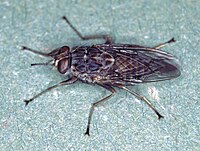
Photo from wikipedia
Prevalence of a parasite may be influenced by age of the habitat (= time available for hosts and parasites to colonize habitats), assemblage composition of host and non-host species, or biotic… Click to show full abstract
Prevalence of a parasite may be influenced by age of the habitat (= time available for hosts and parasites to colonize habitats), assemblage composition of host and non-host species, or biotic and abiotic habitat features. For a trophically transmitted parasite, the intermediate host may be consumed by both final hosts and ‘dead-end’ predators that are incompetent to host the parasite. We tested biotic and abiotic factors that might influence parasite prevalence in a freshwater host–parasite system using a dataset collected from 36 water bodies in the vicinity of Edmonton, Alberta, Canada. In this system, eggs of thorny-headed worms (Acanthocephala: Polymorphus spp.) are eaten by intermediate-host amphipods ( Gammarus lacustris Sars), which are then consumed by final vertebrate hosts (certain aquatic birds and muskrats) and various non-host waterbird species. We found that acanthocephalan prevalence in amphipods was positively correlated with waterbody age and with abundance of final-host species. In contrast, abundance of the intermediate host G. lacustris was less important and was negatively correlated with parasite prevalence (‘encounter-dilution effect’). Similarly, parasite prevalence showed a marginally significant and negative correlation with abundance of ‘dead-end’ Gammarus -eating birds. We conclude that in our study system, time available for colonization and abundance of final hosts are more important for parasite prevalence in intermediate hosts than is abundance of intermediate and dead-end hosts.
Journal Title: Oecologia
Year Published: 2020
Link to full text (if available)
Share on Social Media: Sign Up to like & get
recommendations!